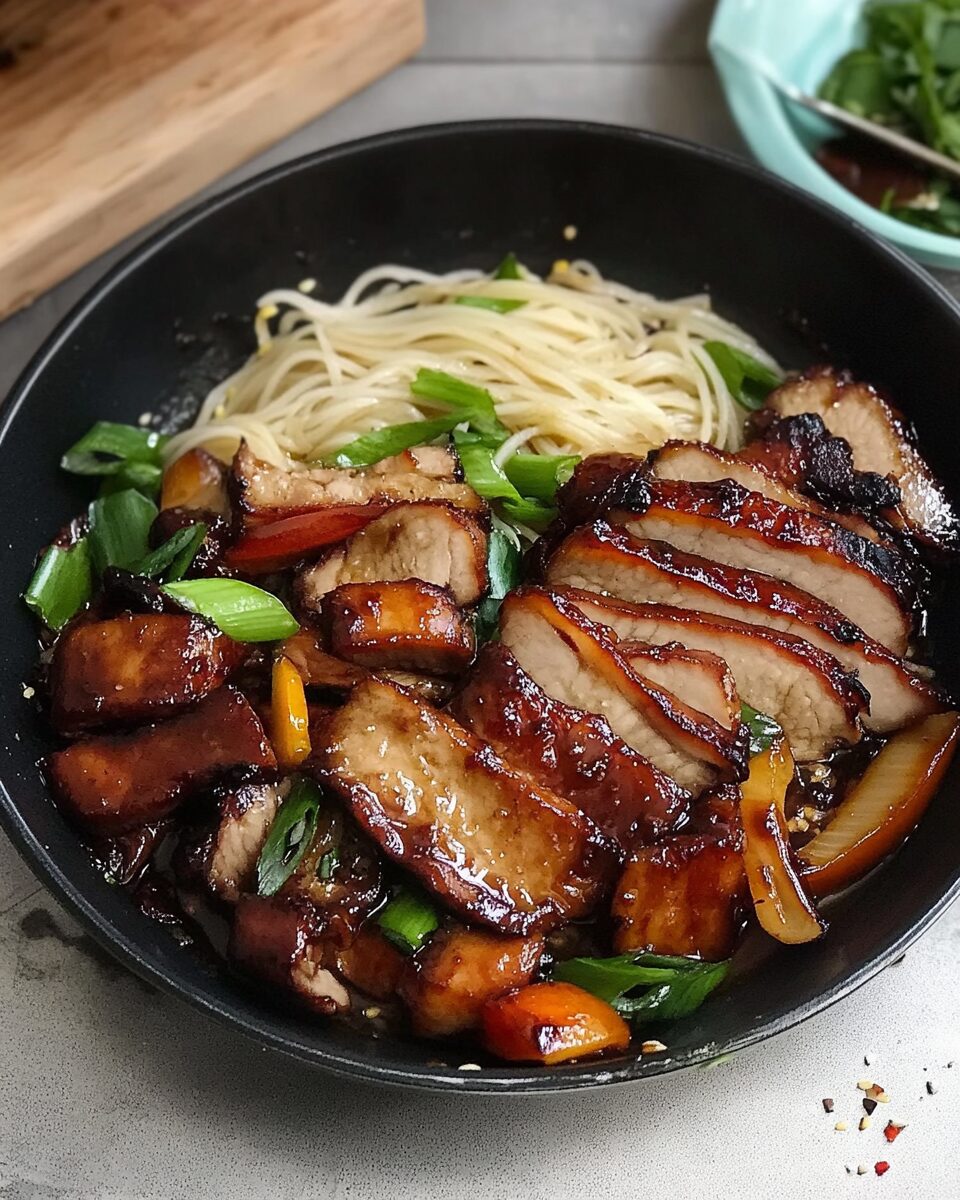Char Siu, or Chinese BBQ Pork, is a beloved dish in Chinese cuisine, known for its tender, juicy pork coated in a sweet, savory glaze. The name “Char Siu” translates to “fork roast” in Cantonese, referring to the traditional method of cooking the pork on skewers over an open flame. The dish is often served with steamed rice or in bao buns, but it can also be enjoyed as a stand-alone meal or used as a filling for various dim sum dishes. The key to Char Siu’s distinctive flavor lies in its marinade, made with a blend of hoisin sauce, soy sauce, Chinese five-spice powder, and other ingredients that infuse the pork with a perfect balance of sweetness, spice, and umami. This recipe offers a delicious and authentic way to recreate this restaurant favorite in your own kitchen.
Full Recipe:
Ingredients
- 1 lb pork tenderloin or pork shoulder
- 2 tablespoons hoisin sauce
- 2 tablespoons soy sauce
- 1 tablespoon rice vinegar
- 1 tablespoon Chinese Shaoxing wine (or dry sherry)
- 1 tablespoon honey
- 1 tablespoon brown sugar
- 1 teaspoon Chinese five-spice powder
- 1/2 teaspoon ground white pepper
- 2 cloves garlic, minced
- 1/2 teaspoon red food coloring (optional)
- 1 tablespoon vegetable oil (for basting)
Directions
- In a bowl, combine the hoisin sauce, soy sauce, rice vinegar, Shaoxing wine, honey, brown sugar, Chinese five-spice powder, white pepper, and garlic. Stir until the sugar is dissolved and the marinade is smooth. If desired, add the red food coloring for the signature red hue of Char Siu.
- Slice the pork tenderloin or shoulder into strips about 1 1/2 inches wide, ensuring they are of similar size for even cooking.
- Place the pork strips into a shallow dish and pour the marinade over the pork. Toss the pork to coat it evenly. Cover and refrigerate for at least 4 hours, preferably overnight, to allow the pork to absorb the marinade flavors.
- Preheat the oven to 400°F (200°C) and line a baking sheet with aluminum foil. Place a wire rack on top of the baking sheet.
- Remove the pork from the marinade, reserving the marinade for basting. Arrange the pork strips on the wire rack.
- Roast the pork in the preheated oven for about 20 minutes. After 20 minutes, brush the pork with some of the reserved marinade and roast for another 15-20 minutes, until the pork is fully cooked and has a deep caramelized color.
- Once done, remove from the oven and let the pork rest for a few minutes before slicing it into bite-sized pieces. Serve with steamed rice, in bao buns, or as part of a larger Chinese meal.
Nutrients
- Calories: 220 kcal per serving
- Fat: 10g
- Saturated Fat: 2g
- Cholesterol: 65mg
- Sodium: 600mg
- Carbohydrates: 12g
- Fiber: 1g
- Sugar: 9g
- Protein: 21g
The Key Ingredients That Make Char Siu Special
What sets Char Siu apart from other roasted meat dishes is its distinctive marinade, which imparts a sweet, savory, and aromatic flavor that makes the pork incredibly tender and flavorful. The ingredients in the marinade are crucial in achieving the signature taste of this dish.
-
Pork: The most commonly used meat for Char Siu is pork, typically from the shoulder or tenderloin. Pork is chosen because it’s tender and juicy, absorbing the marinade flavors beautifully. It also cooks well at high temperatures, allowing for the charred, caramelized exterior that defines Char Siu.
-
Hoisin Sauce: This thick, sweet, and savory sauce is one of the main ingredients in the marinade for Char Siu. Made from fermented soybeans, sugar, garlic, and spices, hoisin sauce adds a rich umami flavor that balances the sweetness of the other ingredients. It’s this sauce that gives Char Siu its unique, bold taste.
-
Soy Sauce: Soy sauce provides saltiness and depth to the marinade. It enhances the savory aspects of the dish, creating a perfect balance with the sweetness of hoisin and sugar.
-
Chinese Five-Spice Powder: A mix of spices, including star anise, cloves, Chinese cinnamon, Sichuan peppercorns, and fennel seeds, five-spice powder is a cornerstone of Chinese cooking. In Char Siu, it adds complexity and warmth, enhancing the sweetness of the pork and giving the dish a fragrant, aromatic profile.
-
Sugar and Honey: The sweetness of Char Siu is a defining characteristic of the dish, and it comes from the use of brown sugar and honey in the marinade. These ingredients caramelize during the cooking process, creating the glossy, red-brown exterior that makes Char Siu so visually appealing.
-
Rice Wine and Vinegar: Chinese Shaoxing wine or dry sherry provides a subtle depth of flavor to the marinade. Rice vinegar adds a touch of acidity, which helps balance the sweetness and umami, giving the sauce complexity.
-
Garlic: Freshly minced garlic is an essential aromatics in the marinade, contributing its pungent, savory flavor that complements the sweetness and savory depth of the other ingredients.
-
Food Coloring (Optional): Traditional Char Siu often has a distinctive red color. This can be achieved by adding a small amount of red food coloring to the marinade. While not necessary for flavor, the red color has become iconic, and some cooks continue to use it to create the classic look of Char Siu.
Cooking Techniques for Perfect Char Siu
The key to achieving tender, flavorful Char Siu lies not only in the marinade but also in the cooking technique. The traditional method of roasting the meat on skewers over an open flame allows the pork to develop a smoky flavor and caramelized exterior. However, for home cooks without access to a barbecue or roasting pit, there are other effective methods to achieve great results.
-
Oven Roasting: Roasting Char Siu in the oven is a simple and effective way to cook the pork while ensuring it remains juicy and tender. Preheat your oven to around 400°F (200°C) and bake the pork for about 20 to 30 minutes, basting the pork with the reserved marinade throughout the cooking process. This method results in a deliciously caramelized exterior while keeping the inside of the pork juicy.
-
Grilling or Barbecuing: For those with access to a grill, cooking Char Siu over an open flame is the traditional method that imparts the smoky flavor synonymous with this dish. When grilling, ensure that the meat is rotated frequently to avoid burning, while ensuring that it is cooked evenly on all sides.
-
Rotisserie Cooking: If you have a rotisserie function on your grill or oven, this method is ideal for evenly cooking Char Siu. The pork turns slowly on the spit, ensuring that the marinade seeps into the meat and creating a uniform, caramelized coating.
-
Stir-Frying (For Quick Char Siu Dishes): While traditional Char Siu is roasted, you can also use stir-fried Char Siu in quick meals, especially if you’re using pre-cooked Char Siu. Stir-frying the pork adds a crispy exterior and is an excellent way to incorporate Char Siu into fried rice or noodle dishes.
How to Serve Char Siu
Char Siu can be served in many different ways, depending on the occasion and personal preference. The traditional serving style is to slice the roasted pork into bite-sized pieces and serve it with steamed rice. This classic presentation makes for a well-rounded meal, as the rich and savory Char Siu pairs beautifully with the simplicity of the rice.
-
Bao Buns: Char Siu is often used as a filling for bao buns, which are soft, fluffy steamed buns that pair wonderfully with the savory pork. These buns are commonly served as part of dim sum or as a street food snack.
-
Char Siu Fried Rice: Leftover Char Siu makes an excellent addition to fried rice. Its rich flavor and tender texture combine with vegetables, eggs, and soy sauce to create a hearty, satisfying meal.
-
Char Siu Noodles: For a more substantial meal, Char Siu can be added to noodle dishes. Whether served with stir-fried noodles or in a noodle soup, the flavorful pork enhances the overall dish.
-
As a Snack or Appetizer: Char Siu can be served as an appetizer, often in bite-sized pieces or skewered. The tender, sweet pork is easy to enjoy as a snack or as part of a larger appetizer spread.
-
Char Siu in Salads: For a lighter option, Char Siu can be added to a fresh salad. The sweet, savory flavors of the pork pair well with crisp vegetables, creating a delicious contrast.
Conclusion
Char Siu is much more than just a popular Chinese dish; it is a celebration of flavor, history, and tradition. Whether you enjoy it served with steamed rice, in bao buns, or added to a noodle dish, Char Siu’s balance of sweet, savory, and smoky flavors has made it a global favorite.






